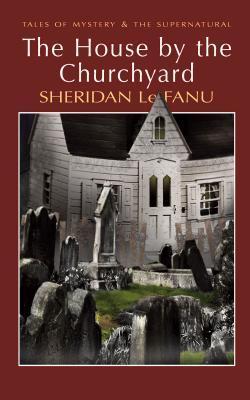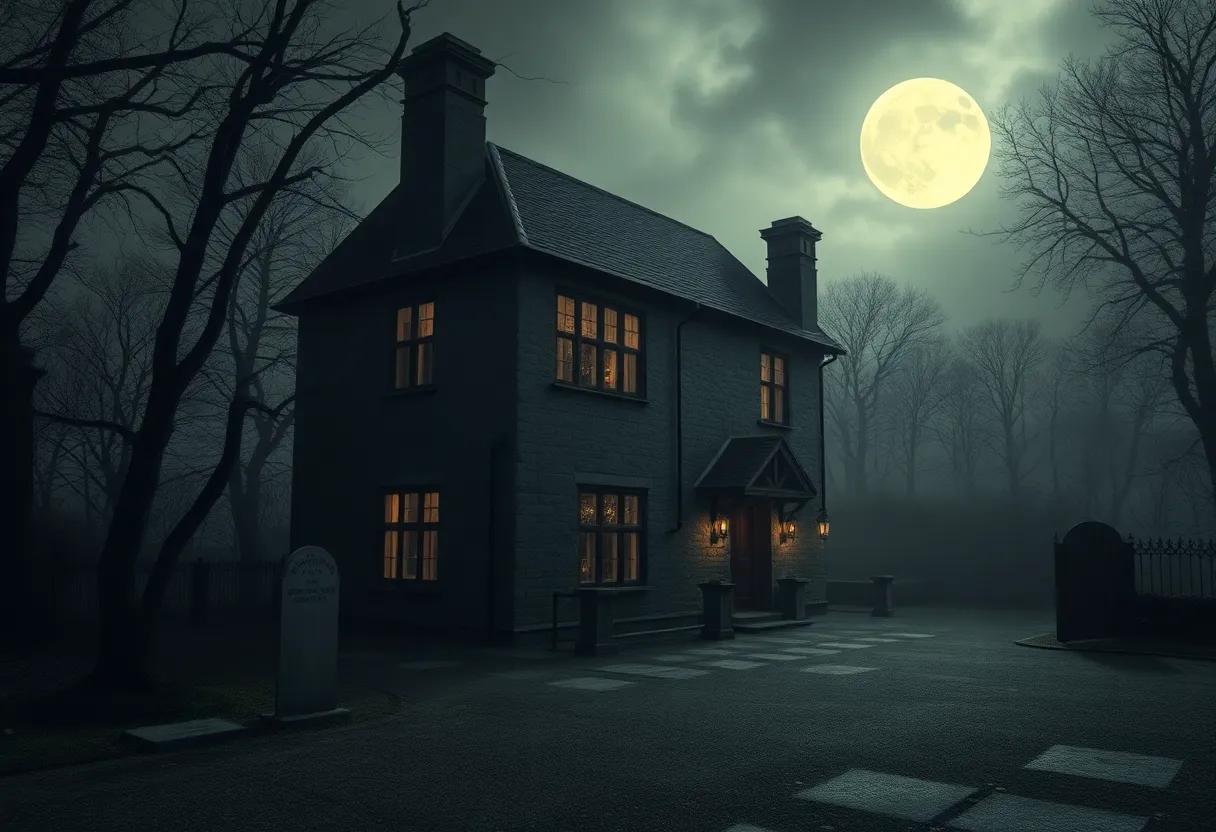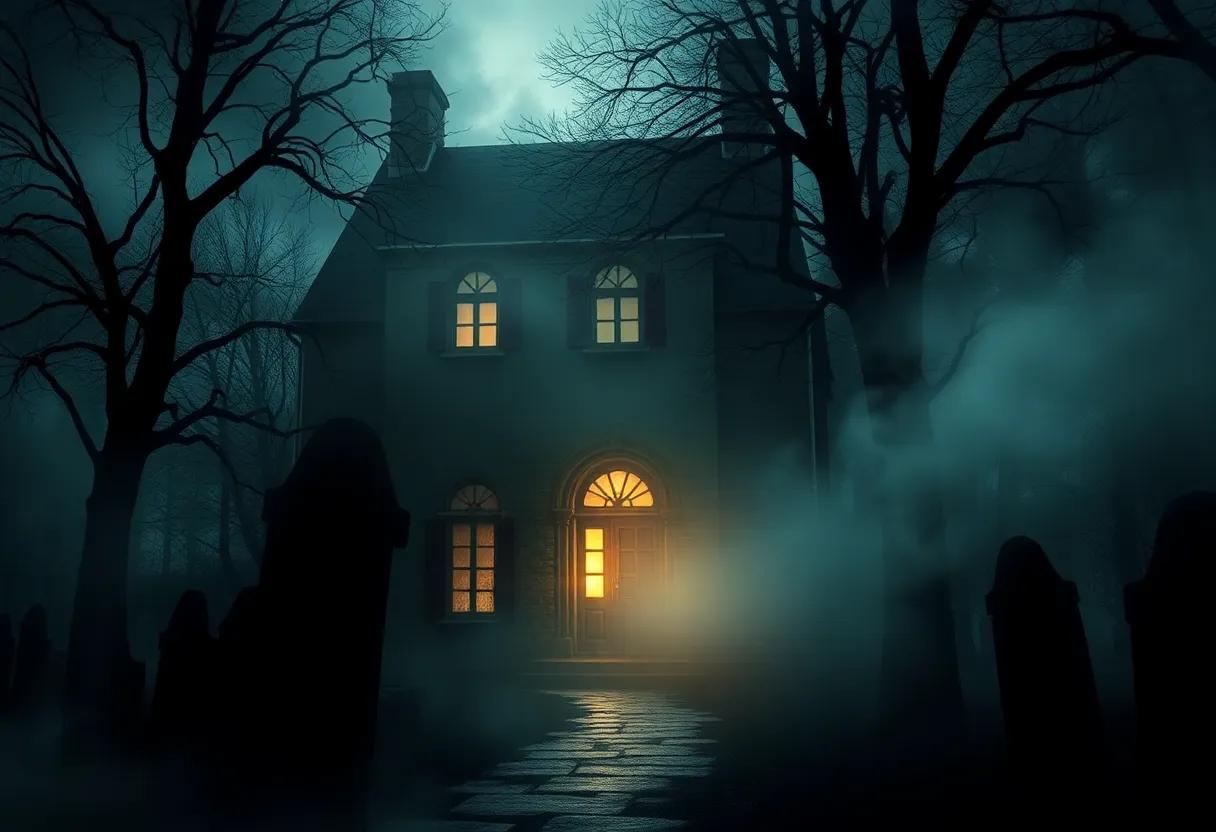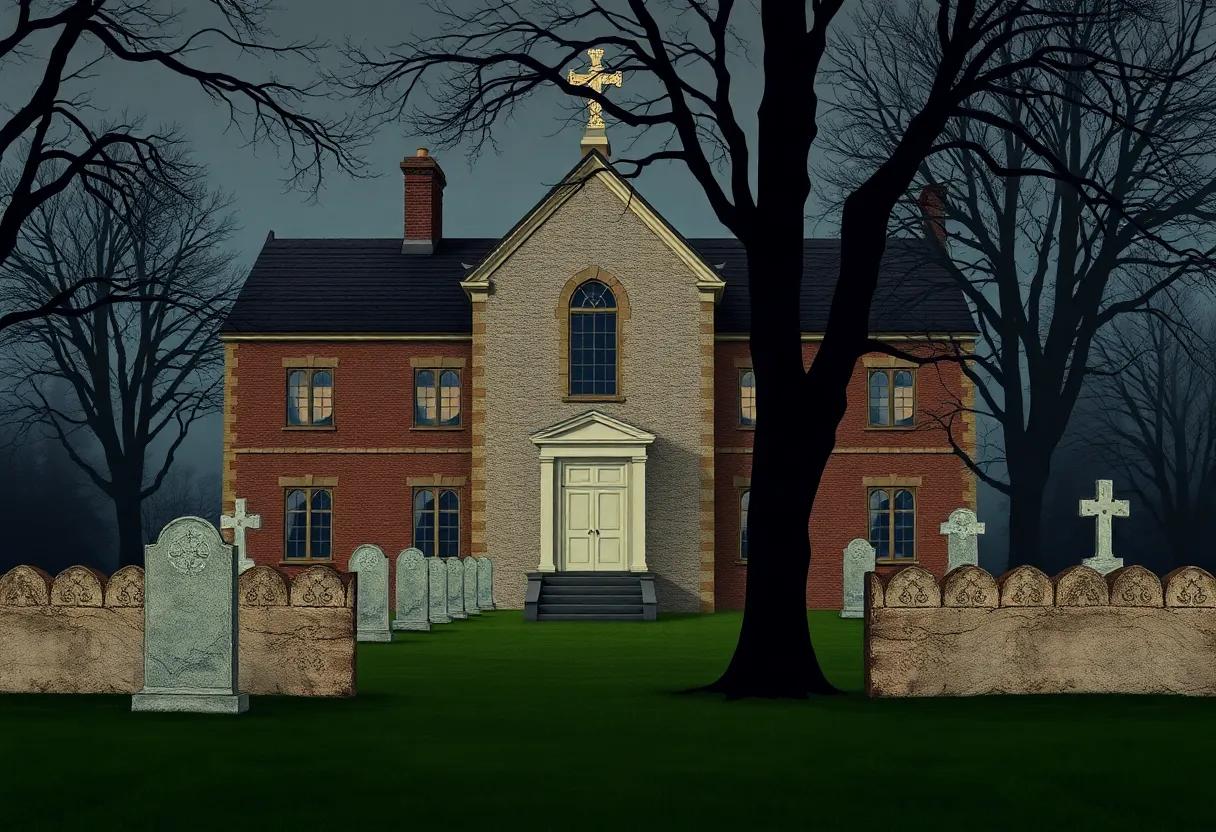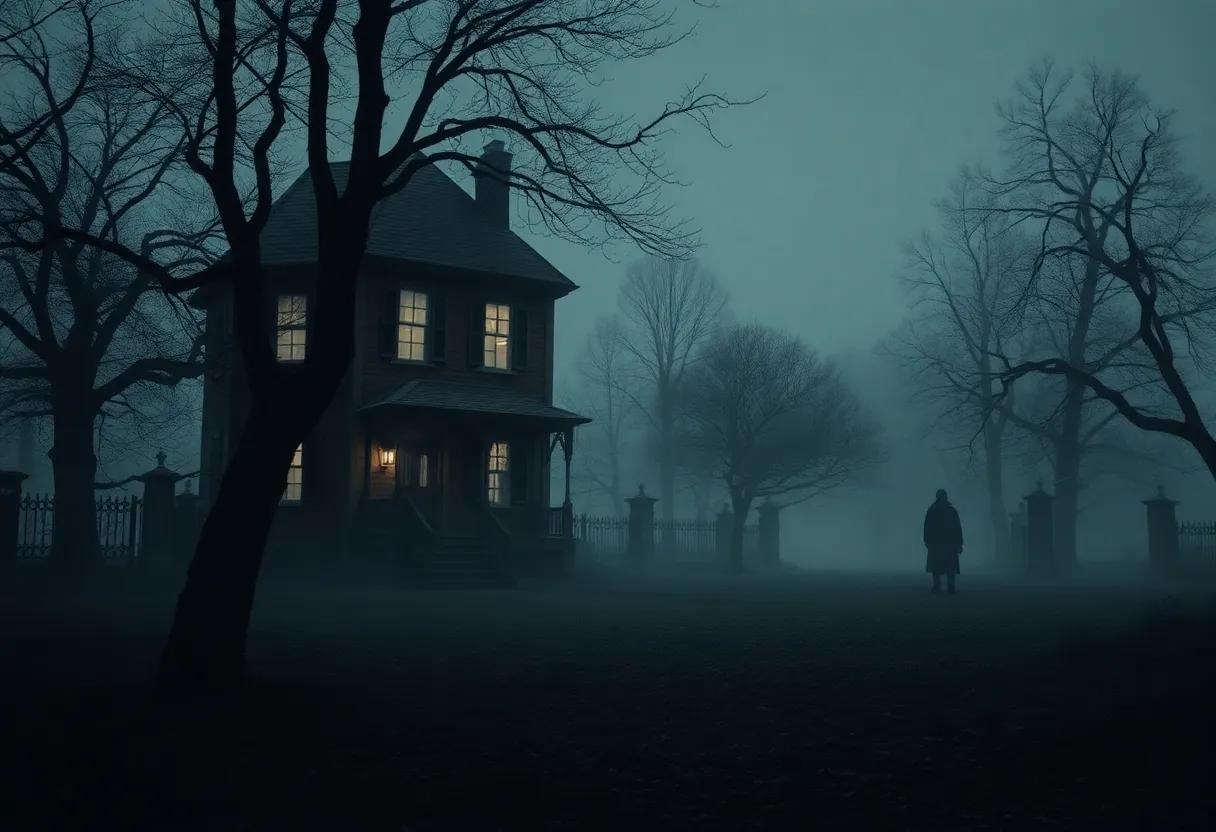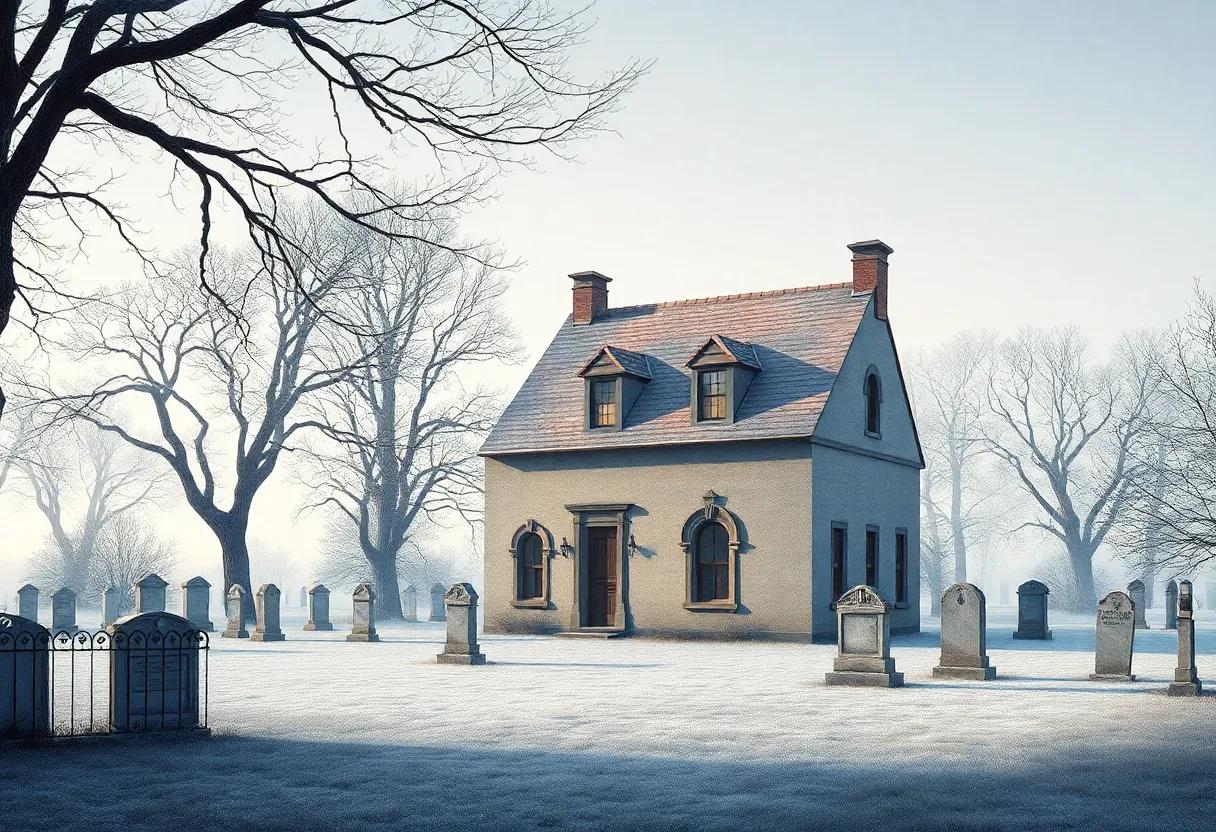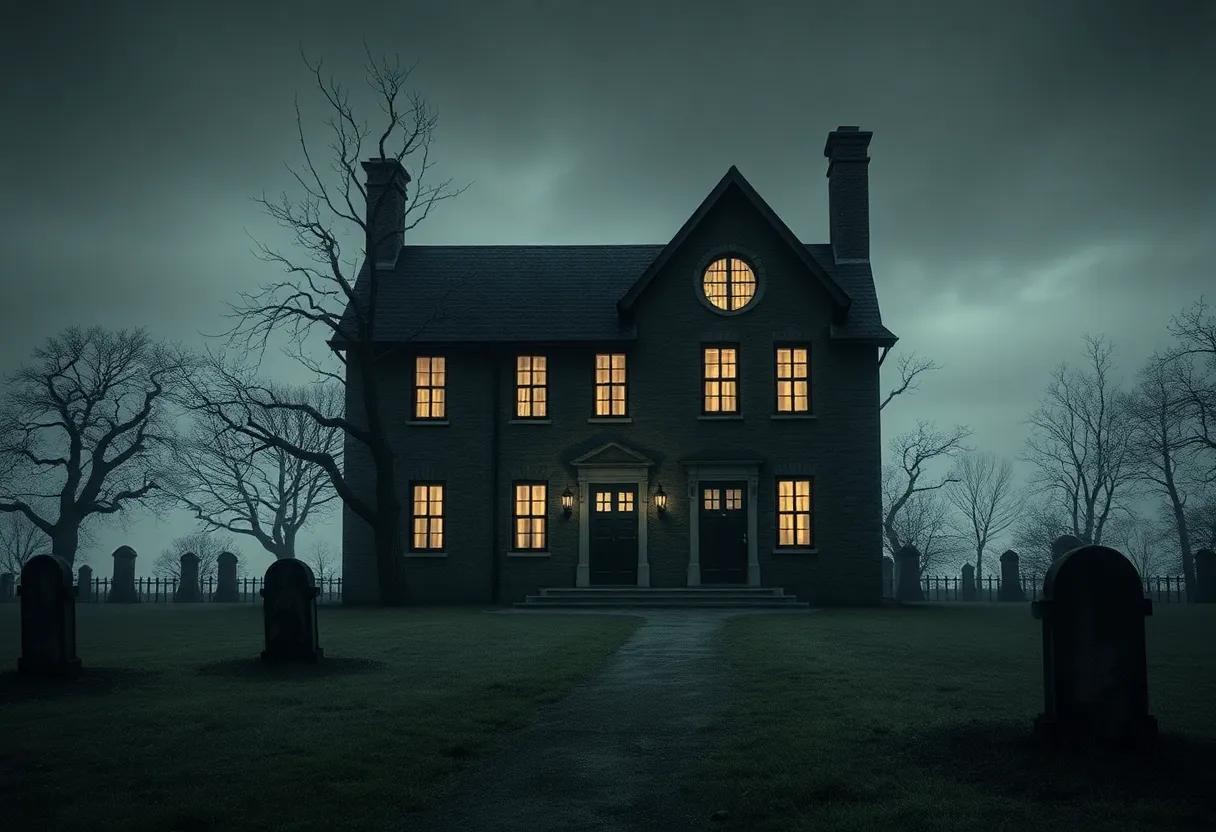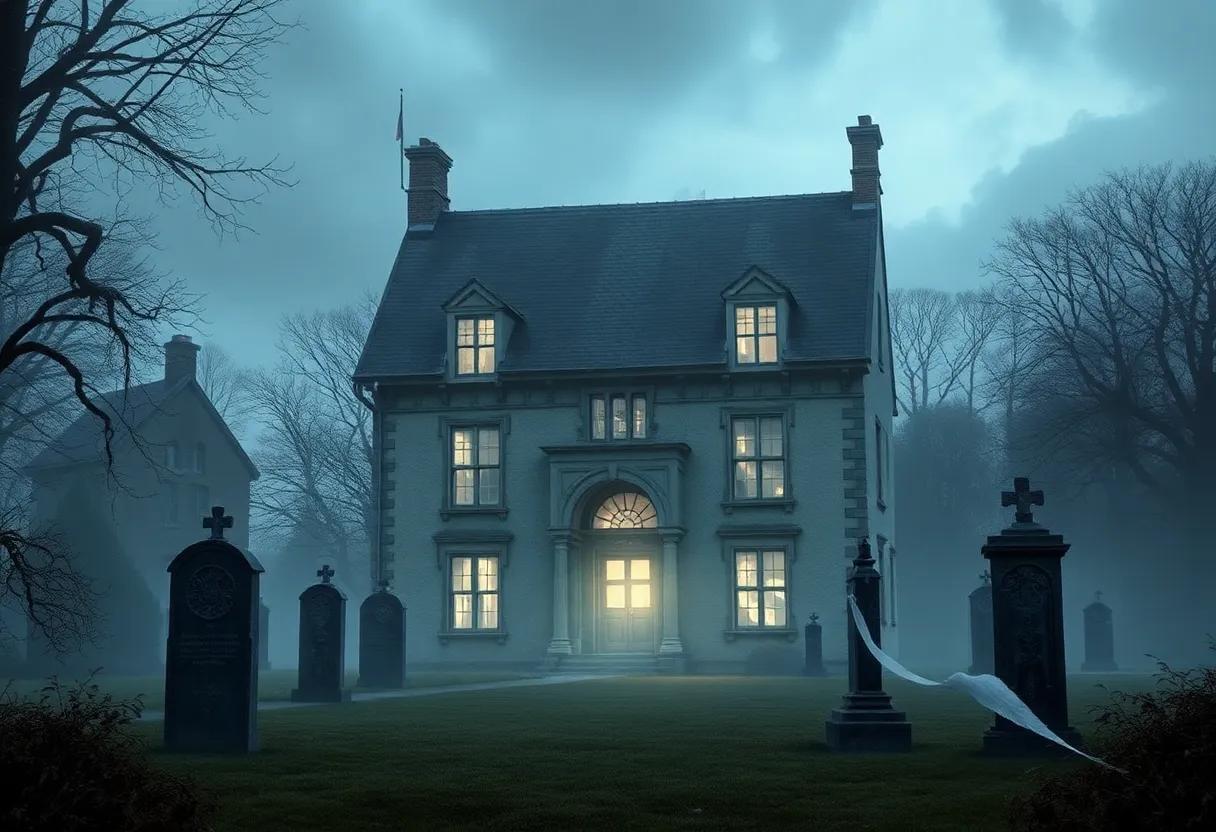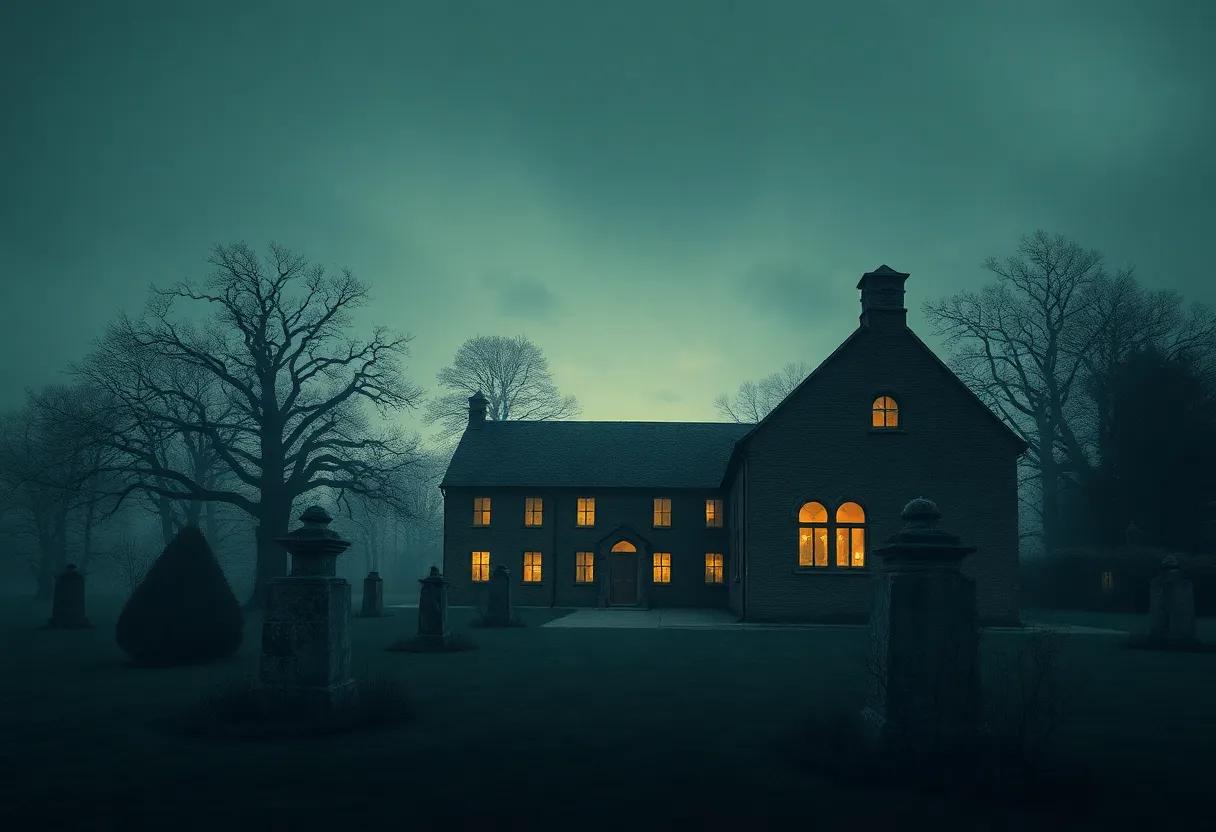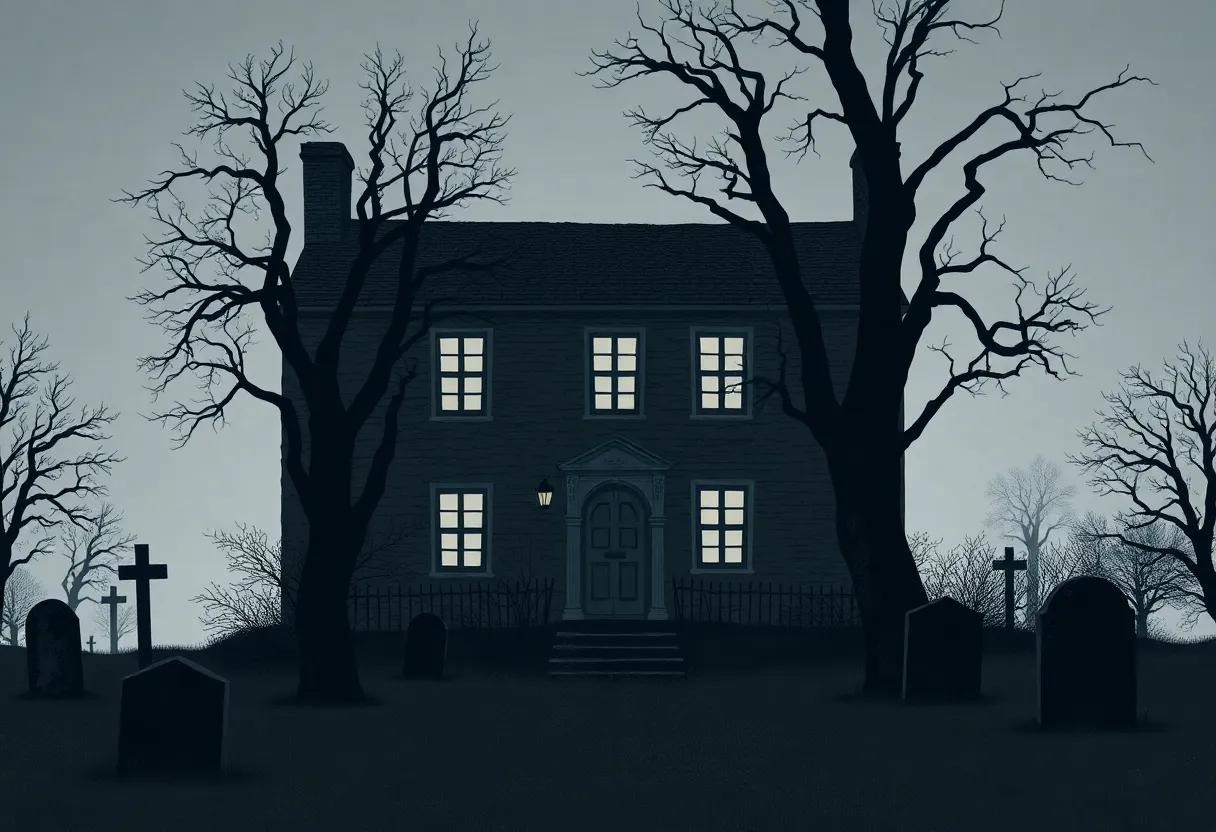In the dim corners of literary history, where shadows loom and whispers echo, J. Sheridan Le Fanu’s “The House by the Churchyard” stands as a remarkable testament to the gothic tradition. This novel, woven with the threads of intrigue, melancholy, and the supernatural, invites readers into a world that straddles the delicate line between the ordinary and the otherworldly. As we delve into the intricacies of Le Fanu’s narrative,we are drawn to explore not only the haunted landscapes of its setting but also the depths of human emotion captured within its pages. This review seeks to illuminate the myriad layers of Le Fanu’s work—an exploration of both the tangible and the spectral, where the churchyard becomes a silent witness to the intertwined fates of its characters. Join us on this journey through the shadows, as we seek to unearth the haunting beauty and complexities of a novel that continues to resonate long after the last page is turned.
The Intriguing Setting of Le fanu’s Gothic Masterpiece: A Deep Dive into the Atmosphere
J. Sheridan Le Fanu’s “The house by the Churchyard” is steeped in a haunting atmosphere that lingers long after the pages are turned. The setting plays a pivotal role in crafting this Gothic narrative, enveloping readers in a world where the mundane intertwines with the supernatural. The story unfolds in a seemingly idyllic village, yet beneath its picturesque exterior lies an undercurrent of tension and mystery. Key elements that contribute to this enthralling ambiance include:
- Isolated Location: The churchyard itself serves as a symbol of death and eternal rest, while the house nearby casts a shadow of secrets yet to be uncovered.
- Atmospheric Descriptions: Le Fanu’s lush and vivid imagery evokes a sense of foreboding, with darkened rooms, flickering candles, and the ever-looming presence of the church steeple, enhancing the gothic essence.
- Character Interactions: The eerie interactions between villagers add layers of complexity, creating a frisson of uncertainty and intrigue.
Moreover, the passage of time accentuates the atmosphere, as the events reveal deeper connections to the past. The contrast between the calm façade and the chaotic undercurrents of village life paints a vivid picture of a world where the past is never truly buried. To illustrate this duality, consider the following table that highlights the contrasting elements present throughout the narrative:
| Element | description |
|---|---|
| Daylight | Illuminates the beauty of the village, offering a false sense of security. |
| nightfall | Shrouds the village in mystery, revealing hidden fears and desires. |
| The Church | Signifies both a sacred refuge and a reminder of mortality lurking at the edge of community life. |
Unraveling the Characters: Complex Personalities in ‘the House by the Churchyard
In J.Sheridan Le Fanu’s The House by the Churchyard, characters are not merely vessels of the plot; they are intricate webs of desires, fears, and secrets that enhance the narrative’s eerie atmosphere. The juxtaposition of light and dark personalities reflects the broader themes of moral ambiguity and social critique present throughout the work. Key figures such as the brooding Captain of the Churchyard and the enigmatic ghostly presence shake the foundations of the quaint village life, illustrating the complex interplay between personal motives and societal expectations. The town’s inhabitants, from the superstitious villagers to the charming yet duplicitous aristocrats, struggle against their own shadows, each revealing layers of depth that resonate with the reader long after the final chapter.
Moreover, the relationship dynamics in the novel encapsulate the essence of human experience, where loyalty and betrayal coexist. As a notable example, the character growth of the innocent yet curious protagonist, along with the morally ambiguous figures around him, creates a tapestry of emotional conflicts. Their intertwining stories unveil a spectrum of traits that can be classified into distinct archetypes, including:
| Character | Archetype |
|---|---|
| Captain of the Churchyard | Tragic Hero |
| Lady Frances | Femme Fatale |
| Simon | The Innocent |
| Dr.Broughton | The Skeptic |
This classification not only paints a vivid picture of the characters but also highlights the social commentary woven through their interactions. Le Fanu’s nuanced portrayal compels readers to grapple with the psychological undercurrents that define each individual, echoing the complexities of human nature within the shadowy corners of the narrative.
The Dichotomy of Light and Dark: Themes of Morality and Redemption
The tension between light and dark in J. Sheridan Le fanu’s “The House by the Churchyard” serves as a rich backdrop against which moral ambiguities unfold.Characters in the narrative traverse a landscape marked by vivid contrasts, as they grapple with the shadows of their pasts and the beacon of potential redemption. Goodness and wickedness are not strictly delineated; instead, they exist in a fluid state where decisions ripple through the lives of the inhabitants.The presence of the churchyard itself stands as a symbolic reminder that, while life is fraught with moral dilemmas, the potential for redemption is always within reach, often situated just beyond the grave.
Key themes of morality within the novel are explored through a variety of characters and their choices, highlighting the complexities of human nature. The interplay between betrayal and loyalty, love and jealousy, and life and death creates a tapestry that reflects the eternal struggle between competing forces. Some characters shine brightly, embodying virtues that inspire hope, while others succumb to despair, their actions entwined with the darker elements of self-interest and vengeance. The layered storytelling invites readers to ponder the duality of existence, prompting an examination of their own moral compass amidst the shadows of the characters’ destinies.
Ghostly Encounters: How Specters Shape the Narrative
In J. Sheridan Le Fanu’s ‘The House by the Churchyard’, the presence of spirits serves as a portal to the past, intertwining the living with the echoes of those who have departed. The novel’s atmospheric setting, infused with gothic overtones, creates a backdrop where specters are not merely figments of the inventiveness, but harbingers of deeper truths lurking beneath the surface of everyday life. As characters encounter these ghostly figures, they grapple with unresolved conflicts and haunting memories that challenge their perceptions of reality and morality. The tension builds as the protagonists navigate the fine line between the material and the ethereal,suggesting that understanding the past is essential for forging a path forward.
Furthermore, the interactions between the living and the supernatural amplify the narrative’s complexities. Each spectral visitation unveils hidden relationships,secrets,and betrayals that shape the fate of the characters involved. The following elements highlight the influence of the spectral in advancing the story’s themes:
| element | Impact |
|---|---|
| Shadows of Guilt | Reveal the characters’ moral dilemmas |
| Lost Loves | Illuminate the consequences of past choices |
| Echoes of Memory | Provide depth to character motivations |
Ultimately, Le Fanu masterfully employs the supernatural to explore the unfinished business of the living, reminding readers that the consequences of actions reverberate through time. Each ghostly encounter encourages a deeper inquiry into identity, loss, and the enduring impact of history on the present, captivating audiences with its intricate tapestry of the known and the unknown.
Historical Context and Influence: The Victorian Era Reflected in Le Fanu’s Work
The Victorian Era, spanning from 1837 to 1901, was a tumultuous time that profoundly influenced literature, art, and societal norms. In this period, marked by rapid industrialization and a strict moral code, the dichotomy between progress and tradition fueled a rich narrative landscape. J. sheridan Le Fanu, with his uniquely gothic outlook, captured the intricate tensions of his time in works like The House by the Churchyard. his storytelling encapsulates the anxieties of urbanization, the elevation of the middle class, and the dangers lurking beneath the veneer of respectability. The novel’s setting—a quaint village contrasted with dark secrets—reflects the Victorian struggle between visible civility and hidden depravity.
Le Fanu’s work is also steeped in the era’s fascination with the supernatural and the occult, as the Victorian population grappled with rapid advancements in science and technology. the novel intertwines elements of mystery,romance,and horror,illustrating how the period’s values influenced literary themes. This interplay is further emphasized through characters that embody both rationality and superstition, mirroring the societal conflict. The following table highlights key elements of Le Fanu’s storytelling that resonate with Victorian themes:
| Element | Description |
|---|---|
| Gender Roles | Explores restrictions placed on women and their struggles for autonomy. |
| moral Dilemmas | Characters face choices that reflect societal expectations vs. personal desires. |
| Supernatural Elements | Utilizes ghosts and folklore to discuss the unknown and the unconscious. |
The Art of Suspense: Crafting Fear and Anticipation in the Reader
In J. Sheridan Le fanu’s “The House by the Churchyard,” the author’s mastery of suspense is evident through his meticulous pacing and the gradual unveiling of sinister truths. The narrative intricately weaves together mystery, gothic elements, and complex characters, immersing readers in a world where every creak of the floorboards hints at deeper anxieties.Le Fanu plants seeds of dread not merely through overt horror but rather by revealing the eerie undercurrents of everyday life, capturing the essence of human fears and the unknown.The use of rich, descriptive language envelops the reader in a thick fog of uncertainty, making every shadow seem filled with unspoken threats.
The suspense peaks as conflicting narratives intertwine, each character harboring secrets that ripple through the plot like ripples in dark water.The psychological tension is heightened through foreshadowing and the clever manipulation of time, leaving readers teetering on the brink of revelation. Notably, the disquieting setting surrounding the titular churchyard becomes a character in itself, embodying the threats lurking in the margins of society.Thus,readers are drawn into a labyrinth of fear,where anticipation—not merely of events but of emotional repercussions—carries them forward,creating an enduring sense of intrigue that persists long after the final page is turned.
Symbolism and Motifs: Recognizing the Hidden Meaning in Everyday Elements
In ‘The House by the Churchyard’, J.Sheridan Le Fanu intricately weaves a tapestry of symbolism that fills each corner of the narrative with dual meanings. The house itself stands as a powerful motif,embodying themes of decay and history. Its crumbling walls whisper secrets of a forgotten past, inviting the reader to explore the depths of memory and loss. This setting serves not only as a backdrop but as a character in itself, reflecting the inner turmoil of those who inhabit it.As the shadows lengthen, the house also becomes a symbol of mortality, looming over the lives that unfold within its grasp, reminding them of their inevitable fate.
Throughout the story, other motifs emerge, enhancing the reader’s journey through Le Fanu’s shadowy prose. Elements such as the churchyard symbolize spiritual refuge juxtaposed with the haunting presence of death.This sharp contrast can be seen in the character interactions that oscillate between the sacred and the profane. Moreover, the recurring motif of light and darkness serves to illustrate the battle between reason and madness. Much like a play of shadows, these dichotomies reflect the characters’ internal struggles, continuously blurring the line between sanity and insanity.The intricate layering of these symbols invites readers to peel back the surface and engage with the text on a deeper level, revealing the often overlooked complexities of human experience.
| Symbol/Motif | Meaning |
|---|---|
| House | Decay, Memory, Mortality |
| Churchyard | Spiritual Refuge vs. Death |
| Light and Darkness | Reason vs.Madness |
A Blend of Fact and Fiction: Notable Real-Life Inspirations Behind the Story
The intricate tapestry of J. Sheridan Le Fanu’s storytelling in The House by the Churchyard is woven with threads drawn from real-life figures and events surrounding the author’s life and the Irish landscape. Among the most notable inspirations is the haunting presence of the infamous Churchyard of St. Michan’s, an ancient burial site in Dublin that evokes a sense of ominous mystery. Its stories of the past, steeped in the supernatural and local folklore, serve as a backdrop for the chilling narrative. The majestic architecture and eerie significance of this landmark invite readers to ponder its influence on Le Fanu’s creation of suspense and terror. Moreover, Le Fanu employs elements from the life of the notorious Dublin Castle, which was notorious for its political machinations and clandestine dealings during the 19th century.
another tangible inspiration can be seen in the character of Captain John, who appears to reflect the complexities of historical figures from the era. Many scholars speculate that this character is a delicate reflection of real-life military officers caught in the turbulent socio-political climate of Ireland, as well as their intertwined fates with the common folk. The narrative emphasizes themes such as social stratification and the impact of political disenfranchisement,mirroring the struggles of the time. Le Fanu’s nuanced portrayals give a palpable authenticity to his characters,leading readers to not only engage with the horrific events of the story but also to reflect on the societal constructs that shape human behavior. Below is a brief table summarizing the key inspirations behind some character arcs:
| Character | Real-Life Inspiration |
|---|---|
| Captain John | Figures of military authority in 19th century Dublin |
| Clerical Figures | Local church leaders with hidden secrets |
| The Villagers | The common folk impacted by political strife |
Narrative Style and Structure: Le Fanu’s unique Approach to Storytelling
In ‘The House by the Churchyard,’ J. Sheridan Le Fanu employs a narrative style that intricately weaves together elements of the gothic and the domestic, immersing readers in a world where the spectral intersects with the mundane. His use of a frist-person narrator coupled with multiple perspectives creates a rich tapestry of voices that enhances the story’s complexity.The narrative unfolds in a layered manner, revealing backstories and hidden motivations that invite the reader to piece together the puzzle of the plot. This technique effectively evokes an atmosphere of mystery and suspense,as the boundaries between reality and the supernatural blur,ensuring that the unsettling essence of the tale lingers long after the final pages are turned.
Le Fanu’s deliberate pacing allows for the gradual buildup of tension, drawing the reader closer into the chilling events that unfold within the house.The structure is characterized by strategically placed flashbacks and interwoven timelines, which not only enrich character development but also create a sense of inevitable doom. By incorporating rich, sensory descriptions, Le Fanu places readers at the heart of the eerie setting, where the scent of decay mingles with the whispers of the past. These stylistic choices culminate in an immersive journey, making Le Fanu’s storytelling not just a means to narrate a tale but an experience that resonates with fear and fascination.
Comparative Analysis: How ‘The House by the Churchyard’ Stands Against Contemporary Works
in delving into J. Sheridan Le Fanu’s ‘The House by the Churchyard’, one cannot help but consider its intricate narrative style and thematic depth in contrast to contemporary literary works.Unlike many modern novels that frequently enough prioritize pace and accessibility, Le Fanu’s writing immerses readers in a rich tapestry of atmosphere and character development. He employs a leisurely pace that invites analysis and reflection, unraveling mysteries through a complex web of relationships and historical context. This traditional approach allows for a profound exploration of themes such as death, morality, and the supernatural, providing readers with both suspense and a meditative experience on the nature of humanity.
When juxtaposed with contemporary works, which may lean towards a direct and often fragmented storytelling technique, ‘The House by the Churchyard’ demonstrates a commitment to the art of storytelling that is increasingly rare. modern fiction frequently showcases streamlined narratives that reflect the fast-paced lives of today’s readers, sacrificing the nuance found in Le Fanu’s prose. Considering this,a comparative analysis reveals key differences in narrative structure,character portrayal,and thematic inquiry:
| Feature | Le Fanu’s Work | Contemporary Works |
|---|---|---|
| narrative Style | Leisurely,atmospheric | Fast-paced,fragmented |
| Thematic Depth | Morality,death,and the supernatural | Varied themes,often driven by current issues |
| character Development | Complex,multifaceted | Often archetypal or simplified |
Timeless Relevance: What Modern Readers Can Learn From this Ghostly Tale
J. Sheridan Le Fanu’s haunting narrative continues to resonate with readers today, not just because of its spectral elements but also due to the profound themes that underpin the story. The exploration of human psychology within moments of crisis and the impact of unresolved histories speak to our current societal struggles.Modern readers can reflect on how the ghosts of the past—be they personal, familial, or societal—frequently enough linger in our daily lives, affecting our decisions and relationships. The interplay between the known and unknown, between light and shadow, offers a rich tapestry for understanding our own complexities.
Moreover, Le Fanu’s eloquent portrayal of setting as a character in its own right emphasizes the importance of place in relation to identity. The eerie atmosphere of the village and the churchyard serves as a reminder that our physical environments can shape our experiences and memories. It encourages us to consider the following:
- Emotional Landscapes: How does your environment influence your feelings and thoughts?
- Personal Histories: What past experiences are influencing your present perspective?
- Community Narratives: How do local stories shape collective identity?
Reflecting on these elements can lead to a deeper understanding of oneself and the wider world, inviting an exploration of both the visible and invisible forces that guide our lives.
recommended Reading: Companion works for an Enriching Experience
To delve deeper into the atmospheric and thematic elements present in J. Sheridan Le Fanu’s *The House by the Churchyard*, consider exploring the following works that complement its rich narrative. These selections collectively enhance the understanding of Victorian literature’s complexities and its exploration of morality, supernatural occurrences, and the human psyche.Here are some notable suggestions:
- Mary Shelley’s *Frankenstein* - A profound exploration of ambition, creation, and the monstrous side of humanity.
- Wilkie Collins’ *The Woman in White* – A captivating tale of mystery and intrigue that embodies the Gothic elements found in Le Fanu’s work.
- Charles Dickens’ *Great Expectations* – Dive into the nuanced character development and the moral fabric of society during the Victorian era.
- Joseph Sheridan Le Fanu’s *Carmilla* – A must-read for those interested in Le fanu’s other explorations of the supernatural and the dark side of desire.
In addition to literature, consider these engaging films that mirror the themes and gothic sensibilities featured in Le Fanu’s narrative. The visual portrayal can evoke a different appreciation for the story’s depth, making them excellent companions to your reading experience:
| Film | Director | Release Year |
|---|---|---|
| The Others | Alejandro Amenábar | 2001 |
| Crimson Peak | Guillermo del Toro | 2015 |
| The Woman in Black | James Watkins | 2012 |
| What Lies Beneath | Robert Zemeckis | 2000 |
Exploring Shadows: Understanding J. Sheridan Le Fanu’s Literary Legacy and Impact
J. Sheridan Le Fanu’s “The House by the Churchyard” serves as a rich tapestry woven with intricate plots and haunting atmospheres, reflecting the author’s mastery of Gothic fiction. Throughout the narrative,the palpable tension between reality and the supernatural invites readers to delve into the depths of human psychology and societal norms of the Victorian era. The intertwining lives of its characters, filled with ambition, betrayal, and revenge, portray a microcosm of 19th-century Ireland, revealing the underlying fears and desires that plague them. Le Fanu’s ability to blend elements of horror with social critique points to a writer who not only engendered fear but also invited reflection on the profound moral ambiguities of his time.
Moreover, the novel showcases Le Fanu’s innovative storytelling techniques, such as fragmented narratives and unreliable narrators, which keep readers constantly questioning the nature of truth within the text. This self-reflexive approach has influenced generations of writers and continues to resonate in contemporary literature. Among the aspects contributing to the novel’s lasting impact are:
- Atmospheric Setting: The churchyard serves as a haunting backdrop, symbolizing mortality and the past.
- Complex Characters: Each character’s motivations and secrets add layers of complexity, making them both relatable and enigmatic.
- sociopolitical Context: The narrative critiques the socio-political fabric of Ireland, reflecting the struggles of its people.
- Blending of Genres: By intertwining elements of Gothic horror with psychological drama, Le Fanu redefined literary boundaries.
Le Fanu’s legacy can be further understood through the key themes represented in the novel, as illustrated in the table below:
| Theme | Description |
|---|---|
| Death and mourning | The omnipresence of death shapes the characters’ lives. |
| Isolation | Many characters are haunted by their pasts, reflecting emotional seclusion. |
| Supernatural | The ghostly elements probe the boundaries of belief and skepticism. |
| Identity | the characters grapple with their own identities amidst societal expectations. |
in encapsulating both the allure and horror of the human experience, “The House by the Churchyard” stands as a testament to J. Sheridan Le Fanu’s enduring influence in Gothic literature. His insights into the human heart and the shadows that dwell within it continue to inspire and provoke thought long after the last page is turned.
To Wrap It Up
As we draw the curtains on our exploration of J. Sheridan Le Fanu’s ”The House by the Churchyard,” we find ourselves standing at the crossroads of memory and mystery. This novel, with its intricate tapestry of Gothic elements and richly drawn characters, invites readers to wander through its shadowy corridors and past the overgrown graves of a forgotten village. Le Fanu masterfully weaves a narrative that lingers in the mind long after the last page has been turned,reminding us of the power of the past and the secrets that dwell within the darkest corners of our lives.
“The House by the Churchyard” is more than just a tale of horror; it is indeed an exploration of the human condition, a reflection on love, loss, and the inexplicable ties that bind us to our histories. Whether you’re a seasoned traveler of the Gothic genre or a newcomer seeking to delve into the eerie charm of Victorian literature, Le Fanu’s work serves as both a haunting reminder of our shared fears and a testament to the enduring allure of storytelling. So, as we bid farewell to this labyrinthine narrative, may we carry with us the echoes of its shadows, forever intrigued by what lies beyond the light.

